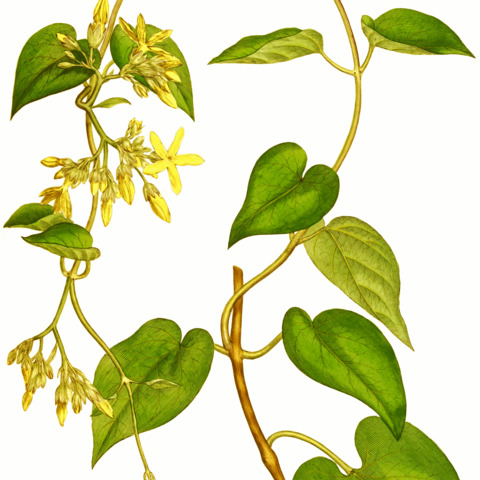Stems 1-10 m, yellowish green, pubescent when new, those of previous year pale gray, glabrescent, usually sparsely lenticellate. Petiole 1.5-5 cm; leaf blade ovate, 4-12 × 3-10 cm, base deeply cordate with narrow sinus, apex acuminate; basal veins 3, lateral veins to 6 pairs. Cymes umbel-like, 15-30-flowered; peduncle 0.5-1.5 cm, puberulent. Sepals oblong-lanceolate, puberulent. Corolla yellowish green; tube 6-10 × 4-6 mm, puberulent outside, pilose or glabrous with pilose throat inside; lobes oblong, 6-12 × 3-6 mm, ciliate. Corona lobes slightly fleshy, basal part ovate, apex acuminate, often notched to deeply lobed, internal appendage often longer than lobe proper. Pollinia oblong or reniform. Stigma head capitate. Follicles lanceolate in outline, 7-13 × 2-3.5 cm, glabrous, somewhat obtusely 4-angled. Seeds broadly ovate, ca. 1 × 1 cm, flat, apex truncate, margin membranous; coma 3-4 cm. Fl. May-Oct, fr. Oct-Dec. 2n = 22.
More
A woody climbing creeper. The stems are slender. They are hairy. The leaf stalks are 4-6 cm long. The leaves are broadly heart shaped. They are thin and often wrinkled. They are pointed at the tip. The flower buds are pale green. They open to yellow 5 petalled flowers. They have a scent at night. The fruit are slender pods and 10-14 cm long. The seeds are up to 1 cm long. They are grey-brown.
A tropical plant. It is best in full sun. It does well in hot, dry, lowland tropical locations. It needs a well drained and fertile soil. It grows in limestone areas. In Yunnan.
More
Open woods, bushland in southern China.

